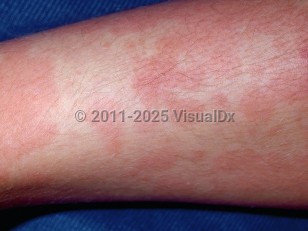Serum sickness in Child
Alerts and Notices
Important News & Links
Synopsis

Serum sickness typically occurs 7-21 days after exposure to exogenous proteins or chemicals. Inciting agents include microbial and venom antitoxins, immunomodulators, vaccines, insect stings, therapeutic fibrinolytic proteins, and allergy immunotherapy.
Antigens induce antibody production, resulting in circulating antigen-antibody complexes that lead to complement activation and release vasoactive amines and cytokines, which give rise to the clinical features.
Risk factors for the development of serum sickness include a higher dose of the medication, certain preparations, repeated exposure, older age, cryoglobulinemia or hypergammaglobulinemia, and an intermittent dosing schedule. Children are less likely to get serum sickness reaction than adults; however, it is high on the differential for a teenager with arthritis.
The disease is usually self-limited and lasts less than one week. Renal, hepatic, pulmonary, gastrointestinal tract, and central nervous system involvement may rarely occur. Previously sensitized hosts can see an accelerated onset of symptoms occurring 1-3 days after exposure to the antigen.
Related topic: serum sickness-like reaction
Codes
T80.69XA – Other serum reaction due to other serum, initial encounter
SNOMEDCT:
213323001 – Serum rash
402658008 – Serum sickness type vasculitis
Look For
Subscription Required
Diagnostic Pearls
Subscription Required
Differential Diagnosis & Pitfalls

Subscription Required
Best Tests
Subscription Required
Management Pearls
Subscription Required
Therapy
Subscription Required
Drug Reaction Data
Subscription Required
References
Subscription Required
Last Updated:08/04/2025

